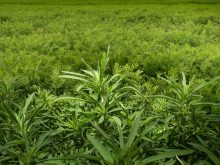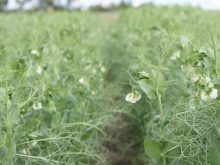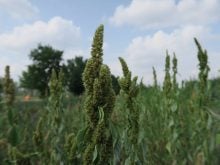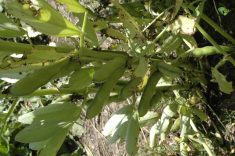Concerns about the spread of kochia continue to grow for Saskatchewan pulse growers.
Michael Brown, agronomy manager for Saskatchewan Pulse Growers, and Martin Carr, agronomy manager for WinField United, have seen the pesky tumbleweed spread throughout Saskatchewan, Alberta and the United States.
The weed is resistant to some herbicides, among them groups 4, 9 and 14, and resistance might extend further, said Brown. That leaves few options for herbicide management.
Kochia tends to emerge early in spring so an early melt and warm temperatures could encourage growth. Scouting and testing will be important this spring.
The weeds are best targeted when they are small; ideally less than five centimetres tall.
“So the one thing I’m thinking is, are we going to be out of the spray stage by the time we’re going in with some of our pre-seed stuff?”
The biggest problem with kochia management is its mobility, said Brown. The tumbleweed packs its bags in fall and will roll until something stops it, spreading 20,000 to 30,000 seeds as it goes.
“In one plant that’s unencumbered, doesn’t have any competition around, are those big ones you can see growing up to six feet tall, kind of looks like a Christmas tree. You’re probably looking at about 100,000 seeds on a plant that size.”

The kochia issue goes beyond farmland. Brown has seen the same problem in new subdivisions. When former farmland is left bare for months while houses are built, marketed, and sold, kochia has nothing to hold it in check. Low-lying areas around railway tracks are also favoured kochia locations.
In residential areas, glyphosate and Group 4 herbicides more commonly used for lawn care are unlikely to work, so Brown said mowing might be a better option.
Carr said many factors affect development of herbicide resistant weeds, including nozzle types, droplet size, spraying rates and product mix.
“The challenge with kochia is how diverse a plant that is. It’s not just that it gets resistant to two or three modes, it can be resistant to eight modes very quickly.”
Using multiple modes of action and other weed management methods are important to address kochia, said Carr. Mowing, using weed seed destructors or even physically pulling heavy patches in small areas of infestation can help.
This goes for many of the weeds on his radar, including wild mustard, buckwheat, volunteer canola and foxtail.
Groups one and two herbicides have been consistent management tools for wild oats but farmers must shift focus as resistance continues to grow. Annual weed surveys show more problems as chemical options shrink, Carr said.
Both agronomists gave presentations to pulse grower groups earlier this year. Carr spoke in Humboldt about herbicide resistant weeds, and Brown gave a pulse outlook presentation in Swift Current, Weyburn and North Battleford.

















